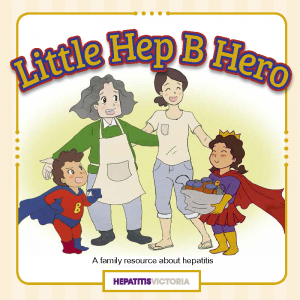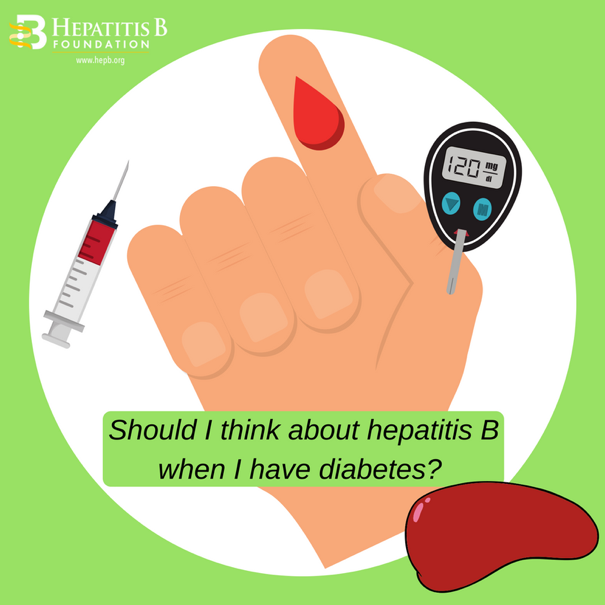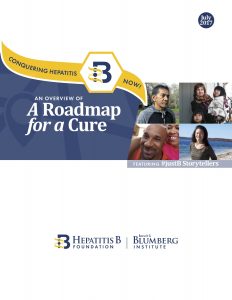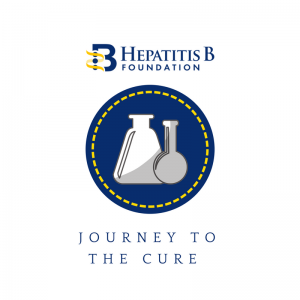In Pennsylvania, the Hepatitis B Foundation is collaborating with various stakeholders to launch a State Viral Hepatitis Elimination Plan! Join us as we document our process from start to finish!

In Pennsylvania, the Hepatitis B Foundation is collaborating with various stakeholders to launch a State Viral Hepatitis Elimination Plan! Join us as we document our process from start to finish!
Genetic conditions can be an unfortunate part of life, but with information and support, some can be managed. By sharing your family health history and learning about genetic disorders that run in the family, measures can be taken to prevent damage and help your loved ones stay healthy!
Hereditary hemochromatosis is one of the most common genetic disorders. The Centers for Disease Control and Prevention (CDC) reports that approximately 80-90% of hemochromatosis cases are from the hereditary form of the condition1. Due to a mutation in the HFE gene, the body begins to produce too much iron – a process

called iron overload. Iron overload can cause complications in the liver, heart, and pancreas2. According to the National Organization for Rare Disorders (NORD), hereditary hemochromatosis has several names that all refer to the same disorder: bronze diabetes, classic hemochromatosis, hemochromatosis type I, hemosiderosis, HFE-related hemochromatosis, HH, and primary hemochromatosis. The two non-hereditary forms of hemochromatosis are secondary hemochromatosis and neonatal hemochromatosis. Both are considered to be rare. Although the hereditary form is common, the exact number of patients worldwide is unknown. Globally, it is estimated that 1 in 227 individuals of Northern European descent is living with hemochromatosis. In the U.S, an estimated 1 million individuals are impacted as well 2.
Not everyone who has the mutant gene develops hemochromatosis. These individuals are known as “carriers”; they can pass the gene on without suffering from the symptoms. Symptoms include joint pain, fatigue, abdominal pain, unexplained weight loss, and a bronze or grey skin color. For most patients, symptoms do not appear until middle age (40-60) because it takes time for the iron to build up in the body. Males tend to be affected more often than women and experience symptoms at a younger age as well 3,2. Some carriers for the mutant gene may develop a more severe version of the disorder called juvenile hemochromatosis. With juvenile hemochromatosis, patients experience an excessive amount of iron overload that can lead to liver and heart damage between the ages of 15 and 30.
Hemochromatosis, the Liver, and Hepatitis B
While the body needs a certain amount of iron to function, iron overload can be dangerous. Hemochromatosis can lead to two major liver issues: hepatomegaly and cirrhosis. Hepatomegaly is the enlargement of the liver and cirrhosis is the scarring of the liver.  Both issues can impair the liver’s ability to function and filter out toxins that enter the body. They can also increase a person’s risk of developing liver cancer. Recently, two major studies by the University of Exeter and the U.K. University of Connecticut, and the U.S. National Institute on Aging have found that a person living with hemochromatosis has four times the risk of developing a liver disease than a person who is living with the disorder.
Both issues can impair the liver’s ability to function and filter out toxins that enter the body. They can also increase a person’s risk of developing liver cancer. Recently, two major studies by the University of Exeter and the U.K. University of Connecticut, and the U.S. National Institute on Aging have found that a person living with hemochromatosis has four times the risk of developing a liver disease than a person who is living with the disorder.
For individuals living with hepatitis B, it is extremely important to understand any behaviors or conditions that may have a negative impact on your liver. Since one liver disease can increase your risk of another liver disease, it is important to identify the disorder as early as possible, especially if you have any of the following risk factors:
Risk Factors for Hereditary Hemochromatosis:
Risk Factors for Secondary Hemochromatosis:
Hepatitis B patients do not have an increased risk of developing hemochromatosis4. However, if you have any of the above risk factors, it is important to get tested. Hemochromatosis can easily be identified by a comprehensive look at a person’s family health history, a physical exam, and a simple blood sample. Your doctor will then use the blood sample to run a series of tests that may include transferrin saturation (TS), serum ferritin, or liver function tests. In certain cases, the doctor may also perform genetic testing to see if the mutant HFE gene is present.
Treatment
Treatment for hemochromatosis is available! Based up tests results, family history, medical history, and the appearance of symptoms, the doctor may suggest a few different treatment methods. In therapeutic phlebotomy – the most common treatment method – a patient undergoes regular blood draw to lower the amount of iron in the body. This method is effective, affordable, and typically lasts for an extended period of time. Through iron chelation therapy, patients can either receive an injection or orally consume a medication that will lower the amount of iron in your blood. Finally, some doctors may suggest changes to your diet, such as eating less vitamin C, avoiding alcohol and shellfish, and not taking iron supplements. Dietary changes are mainly used to prevent liver damage.
For more information on HH, you can visit the National Heart, Lung, and Blood Institute.
References:

If you have just been diagnosed with hepatitis B virus (HBV) then you need to understand how HBV is transmitted. This is important whether you have an acute or chronic infection. You must understand you are infectious and can transmit the virus to others.
How is hepatitis B transmitted?
Hepatitis B is transmitted through direct contact with infected blood or certain bodily fluids. The virus is most commonly transmitted from an infected pregnant person to their baby during childbirth, due to the blood exchange that happens between mother and baby. It is also transmitted through unsterile medical or dental equipment, unprotected sex, or unsterile needles. For kids, pediatric experts report that the fluid that oozes from cuts and open sores is also highly infectious, so keep those open cuts covered. Hepatitis B can also be transmitted inadvertently by the sharing of personal items such as razors, toothbrushes, nail clippers, body jewelry and other personal items that have small amounts of blood on them.
Hepatitis B is not transmitted casually by sneezing or coughing, shaking hands, hugging or sharing or preparing a meal. In fact, the virus is not contracted during most of life’s daily activities. You don’t need to keep cups, bowls, plates or utensils separate. Hugging, or even kissing won’t cause infection unless there are bleeding gums or open sores during the exchange. It’s really all about trace amounts of infected blood, though the virus is in other bodily fluids in lower concentrations. For example, it’s not the saliva on the toothbrush that is a big concern, but rather the potential for trace amounts of blood that could be exchanged with a shared toothbrush.
How did I get this? If you have been diagnosed with hepatitis B virus you are likely racking your brain trying to figure out how you could have gotten HBV. Some can immediately track their likely exposure to a recent event, or perhaps a time period in their life where they were more likely to have been exposed. They may fit into an at-risk category for hepatitis B due to lifestyle choices, country of origin, frequent travel and exposure in endemic areas of the world, or an unsafe blood transfusion, or medical or dental procedures performed without proper infection control. Some may never know how they were infected. What is important is that you are now aware.
Since HBV is a silent infection there can be years before it is detected. Many individuals born in endemic parts of the globe find out later in life that they are hepatitis B positive, even though they have likely had HBV since birth or early-childhood. Children are especially vulnerable to chronic HBV. Greater than 90% of babies and up to 50% of young children infected with HBV will remain chronically infected, and most will have no symptoms. Often it remains undetected until it is caught in routine blood work, blood donation, or later in life after there is liver inflammation or disease progression. In Asia, vertical transmission from mother to child is particularly common; whereas in Africa, horizontal transmission at a young age may be more likely.
Although not casually transmitted, there are inadvertent opportunities for exposure to hepatitis B. If you are from an area where HBV is very common, then the odds of exposure, transmission, and infection will be higher. Many are surprised when family is tested, and they learn hepatitis B appears to “run in their family”. Hepatitis B is NOT genetic! It is not carried on the sperm of a man or the egg of a woman, but it is very easily passed from an HBsAg positive mom to her baby at birth. Hep B is a vaccine preventable disease, but not all moms living with the virus have access to the birth dose for their baby or able to complete the vaccine series, or they have a high viral load resulting in failure of HBV birth prophylaxis. The good news is that today we can prevent the transmission of hepatitis B to the next generation.
If you do, or have participated in high-risk activities at some point in your life, you are also at greater risk. This is not a time to judge or be judged.
Time to move forward. Unless your infection is acute and you can definitively identify your exposure, I would advise that you let it go and move forward. I spent a number of years wondering about the details of my daughter’s infection, but ultimately, it really didn’t matter. What is important is seeing a doctor to learn more about your infection, getting treatment if you need it, preventing transmission to others, and moving forward with your life.

Have you recently been told you have hepatitis B? Dealing with the diagnosis and waiting out the next six months to determine if your infection will resolve itself or learning that it is a chronic infection can be nerve-wracking.
Fortunately, greater than 90 percent of healthy adults who are newly infected will clear or resolve an acute hepatitis B infection. On the hand, greater than 90% of babies and up to 50% of children infected with hepatitis B will have lifelong, chronic infection. Sometimes people are surprised to learn they have a chronic infection. It can be confusing since there are typically few or no symptoms for decades. If a person continues to test hepatitis B positive for longer than 6 months, then it is considered a chronic infection. Repeat testing is the only way to know for sure.
Acute hepatitis B patients rarely require hospitalization, or even medication. If you are symptomatic, (some symptoms include jaundice, dark urine, abdominal pain, fever, general malaise) you may be anxiously conferring with your doctor, but if you are asymptomatic, you might not feel compelled to take the diagnosis seriously. Ignoring your diagnosis can be very serious. If you have concerning symptoms like jaundice (yellow eyes and skin), a bloated abdomen or severe nausea and vomiting, please see your doctor immediately. Your doctor will be monitoring your blood work over the next few months to see if you clear the virus, or monitoring your liver if there are concerning symptoms.
Your job is to start loving your liver …today. STOP drinking alcoholic beverages. Refrain from smoking cigarettes. Your liver is a non-complaining organ, but you cannot live without it. Make your diet liver-friendly and healthy filled with a rainbow of vegetables and fruits, whole grains, fish and lean meats. Minimize processed foods, saturated fats and sugar. Drink plenty of water.
Talk to your doctor before taking prescription medications, herbal remedies, supplements or over-the-counter drugs. Some can be dangerous to a liver that is battling hepatitis B. Get plenty of rest, and exercise if you are able.
Don’t forget that you are infectious during this time, and that loved ones, sexual partners and household contacts should be tested to see if they need to be vaccinated to protect against hepatitis B. Sometimes family members or close household contacts may find that they have a current infection or have recovered from a past HBV infection. If anyone fears exposure, ensure them that hepatitis B is not transmitted casually. They should get tested, and vaccinated if needed, and take simple precautions. Remind them that 1/3 of the world’s population will be infected with the hepatitis B virus during their lifetime.
On the flip-side… Do not let this new hepatitis B diagnosis consume you. As the weeks and months pass, you might find that the infection is not resolving, and you might worry that you have a chronic infection. The associated stress and anxiety can be challenging, even overwhelming. It can contribute to physical symptoms you may be experiencing. Find a family member, friend, or health care professional with whom you can share your concerns.
If you are told you have recovered from an acute HBV infection (you are now HBsAg negative, HBcAb positive and HBsAb positive) be sure to get copies of your lab reports to ensure there are no mistakes. Compare them with our easy to use blood tests chart. If something looks wrong, or if you’re confused, speak up and ask your doctor. Once confirmed, be sure to include hepatitis B as part of your personal health history. This is important in case you have conditions requiring treatment later in life that might once again warrant monitoring of your hepatitis B. It is possible for a past HBV infection to reactivate if a person requires longterm immune suppressing drugs .
No one wants to learn they have chronic hepatitis B but it is a manageable disease. You’ll want to see a doctor with experience treating chronic HBV so they can run additional tests. There are very effective treatments available, though not everyone with chronic HBV needs treatment. All people living with chronic HBV benefit from regular monitoring since things can change with time. Please do not panic or ignore a chronic hepatitis B diagnosis. Take a deep breath and get started today learning more about your HBV infection and the health of your liver. Things are going to be okay!
If you are confused about your diagnosis, please feel free to contact the Hepatitis B Foundation at info@hepb.org.
Little Hep B Hero, which is available in English, Simplified Chinese and Vietnamese, gives children and their families a delightful glimpse into a young girl’s visit to her neighbor and friend, Rosa. As Rosa and the young girl prepare food and lemonade together, Rosa tells her about living with chronic hepatitis B. Rosa explains what the liver does, what hepatitis B is, how the virus is transmitted, how she maintains a healthy lifestyle with chronic hepatitis B, and shares tips on preventing hepatitis B transmission. Little Hep B Hero also provides cute and easy to understand visuals of the little girl as a superhero while Rosa explains this information.
The book does an excellent job of explaining liver functions and what the hepatitis B virus does to the liver! The analogy of using a sieve to demonstrate how the liver filters toxins in the body was creative. The book also does a great job of indirectly tackling some myths associated with hepatitis B. For example, people are often hesitant to share meals with those living with chronic hepatitis B. Little Hep B Hero lets its audience know that you cannot get hepatitis B through food preparation or sharing a meal, so Rosa cooks a meal for her neighbors.

Little Hep B Hero is an important read for future generations and their families! Getting the conversation started early about hepatitis B will address the stigma and discrimination associated with it. When children are talking about hepatitis B and are knowledgeable about it, hepatitis B isn’t a scary topic anymore. The message of hepatitis B as a family matter highlights the importance of educating and testing family members.
For more information, check out their press release, and to purchase Little Hep B Hero, visit Hepatitis Victoria’s website here.
 March 27th is Diabetes Alert Day!
March 27th is Diabetes Alert Day!
Diabetes is a chronic condition that is characterized by high glucose (or sugar) levels in the blood. It usually occurs when a person cannot produce enough insulin, a hormone that controls blood sugar levels. According to the World Health Organization (WHO), global prevalence of diabetes is on the rise! In 1980, diabetes prevalence in adults over the age of 18 was 4.7%. The number rose to 8.5% in 2014 and continues to increase. In 2015, there was an estimated 1.6 million deaths that were attributed to diabetes.
Like hepatitis B, there have been several studies that show a strong link between type II diabetes and liver cancer. Diabetes and hepatitis B can be a dangerous combination and can work together to increase someone’s risk of developing liver cancer.
Since the hepatitis B virus can be transmitted via blood or other bodily fluids, people living with diabetes are at an increased risk of contracting hepatitis B. In fact, one study found that people living with diabetes between the ages of 23-59 have an approximately two-fold increased risk of hep B infection compared to those without diabetes. According to the Centers for Disease Control and Prevention (CDC), there have been hepatitis B outbreaks in nursing homes, assisted living, and long-term care facilities among people living with diabetes. Some risks for transmission include:
So, what can you do if you are living with diabetes to prevent hepatitis B transmission?
For more information about hepatitis B and diabetes, WHO, CDC, and/or American Diabetes Association. For a personal account of hepatitis B and diabetes, visit Martha Zimmer’s blog post. You can also visit our website for information about diabetes and liver cancer
Happy Valentine’s Day!! Today is dedicated to celebrating love. Though it can be exciting, anxiety can creep up on this day too. Maybe you’re thinking about confessing your feelings to your crush? Or nervous about planning the best date ever? Maybe you’re timid about the holiday in general because of your hepatitis B status?

If you have chronic hep B, you may think that starting a relationship and initiating sex can be stressful and feel overwhelming. Questions like “What if we break up because I disclosed my status?” or “Can I even start a relationship with someone if I have a chronic disease like hepatitis B?” may be swimming in your mind. Doubt and anxiety may overwhelm your thoughts, but don’t forget that you’re more than your illness. You should not focus on things you cannot change. You are worthy of love and can live out that romantic story you always wanted because you have wonderful things to offer to a future love interest.
If you’re spending time with someone on Valentine’s this year or any day, it’s important that you remember to take precautions if your date leads to an intimate night. If you are living with hep B, properly wearing a latex condom keeps you safe from becoming co-infected with another infectious disease. No one wants a co-infection. It is complicated and potentially dangerous for you and your partner’s health. If your partner does not have hep B, then avoid infection by wearing a condom. Hep B is vaccine preventable, but hepatitis C, HIV and other sexually transmitted infections (STIs) are not. Considering the health and safety of yourself and your sexual partners is paramount. You may not know what they have, and they may not know what you have.
Also, it is important to disclose your status before sex (even if it’s safe sex with a condom). You may jeopardize your partner’s trust (and their health) before the relationship deepens. Disclosing your chronic hep B status can be scary, but talking about it reduces the stigma surrounding the infection and may even prompt your partner to get tested or vaccinated if needed. If your partner is not understanding after you have explained your HBV infection, then you know that person was not meant for you, and not deserving of your love. There are other potential partners out there that will be understanding and loving. Do not let rejection discourage you!
Disclosure should be done calmly and carefully. It is important to do some research before you do disclose your hepatitis B status. Having a thorough understanding of hepatitis B can make it easier for you to explain it to a future partner. The more you know, the less scary and more comfortable it is to dispel fear, so that you can share your status with confidence and integrity.
Whether you think of today as Valentine’s or Single Awareness Day, remember that hep B is only a small part of who you are and should not be a reason for you to give up on loving someone. Remember that you are more than your chronic hep B! It’s only a part of you and does not define your entire life. You have so much to offer to your current or future partner!
Read our previous posts about dating and hepatitis B, advice for navigating the dating world for those with hepatitis B, disclosing your status on Valentine’s, loving safely on this holiday, and tips for disclosure (or a #justB video).
How are your New Years’ Resolutions going? When you were making your resolutions, did you consider hepatitis B specific New Year’s resolutions? Here are a few ideas…

Check out our previous post about New Year’s resolutions to get more ideas and tips!

Do you ever feel like life is kicking you in the butt? Or do you ever feel like life is dragging you down? Though it may be hard preventing negativity from pulling you into a rut when you have a chronic condition, like hepatitis B, being more positive can help lift your spirits. When you do this, you can improve your health-related quality of life!
Though there is no set definition for health-related quality of life, the CDC defines it as an individual’s or a group’s perceived physical and mental health over time. Health related quality of life explains how a person’s physical, emotional, mental and social aspects impact their overall life. Health-related quality of life can impact your overall well-being, which the CDC defines as “a positive outcome that is meaningful for people.” Basically, improving health-related quality of life and overall well-being can help people feel that things are going well in their lives. Ultimately, this can help decrease stress and improve how well someone manages a chronic illness. This can be very useful for those of us living with the physical, emotional and social aspects of chronic hepatitis B..
Here are some tips and suggestions on how you can improve your health-related quality of life:
These are just a few tips and suggestions on how you can improve your health-related quality of life. There are many articles and resources online with more tips and suggestions on how to improve your quality of and feel more positive! Some websites include CDC’s Health-Related Quality of Life program, advice on how to cope with your chronic illness from HealthCentral, and Huffington Post’s Habits to Improve your Life.
Remember that everyone goes through ups and downs in life, especially those of us living with a chronic illness. But working to make small, positive changes in your life gives you the power to live your best life!

Play our podcast clip here!!
2017 was a big year for us at the Hepatitis B Foundation! I’ll give you a rundown of some of our accomplishments over the year.
We started the year off with a fresh new look! We got a new logo!

We also launched our national storytelling campaign, “#justB: Real people sharing real stories of hepatitis B,” in partnership with StoryCenter and AAPCHO. Fifteen people have shared their stories to bring a human face to hepatitis B and help increase public awareness, decrease stigma and discrimination, and promote testing and treatment for hepatitis B. Look for new stories in the coming year!
We have had a few additions to the HBF leadership team this year. Dr. Nat Brown, Ram Kapur, Dr. Su Wang, and Dr. Carol Brosgart all joined our board of directors. Dr. Francis Chisari and Dr. Robert Perrillo joined the scientific and medical advisory board.

After 25 years of service, our amazing and dedicated co-founder Joan Block retired in June. Without Joan, we would not have many of the programs we have today, especially the ones that provide multi-platform, multi-lingual educational materials, newsletters, and email and telephone helplines. She also pioneered a robust advocacy presence in Washington, D.C. that has resulted in hepatitis B becoming a protected condition under the Americans With Disabilities Act to prevent discrimination, and increased federal funding for hepatitis B and liver cancer research.
 May was definitely a big month. Not only because we had numerous screening events and celebrations for Hepatitis Awareness Month, but also because we launched our Hep B Cure Campaign. The Hep B Cure Campaign is a national advocacy campaign to Double the Federal Funding within five years for hepatitis B and liver cancer research and public health. In March, we convened a virtual workshop with more than 30 of the world’s leading scientists to determine the research needed to find a cure for hepatitis B, and identify specific research projects in virology, immunology, and liver cancer, as well as strategies for expanding clinical research for therapeutic drug testing. The Hep B Cure Campaign is calling for increased federal investment to accelerate the pace of research for a cure, which will also significantly improve health and economic outcomes. Our full plan can be found in our “Roadmap for a Cure,” which can be found on our website.
May was definitely a big month. Not only because we had numerous screening events and celebrations for Hepatitis Awareness Month, but also because we launched our Hep B Cure Campaign. The Hep B Cure Campaign is a national advocacy campaign to Double the Federal Funding within five years for hepatitis B and liver cancer research and public health. In March, we convened a virtual workshop with more than 30 of the world’s leading scientists to determine the research needed to find a cure for hepatitis B, and identify specific research projects in virology, immunology, and liver cancer, as well as strategies for expanding clinical research for therapeutic drug testing. The Hep B Cure Campaign is calling for increased federal investment to accelerate the pace of research for a cure, which will also significantly improve health and economic outcomes. Our full plan can be found in our “Roadmap for a Cure,” which can be found on our website.
Every year, we hold the crystal ball gala, our signature fundraising event. This event gives us a chance to recognize individuals who have made significant contributions to hepatitis B, and to our local Doylestown community. This year, Professor Mario Rizzetto, MD was awarded the Baruch S. Blumberg Prize for his discovery of the hepatitis delta virus. Marvin and Dee Ann Woodall were honored with the 2017 Community Commitment Award, and our own Joan Block was recognized with the distinguished Founders’ Award.
 Just last week, it was announced that Hepatitis B Foundation’s president and co-founder, Dr. Timothy Block, was named a 2017 National Academy of Inventors Fellow! This is the highest professional accolade given to academic inventors who have demonstrated a prolific spirit of innovation in creating or facilitating outstanding inventions that have made a tangible impact on quality of life, economic development, and welfare of society. Congratulations Dr. Block!
Just last week, it was announced that Hepatitis B Foundation’s president and co-founder, Dr. Timothy Block, was named a 2017 National Academy of Inventors Fellow! This is the highest professional accolade given to academic inventors who have demonstrated a prolific spirit of innovation in creating or facilitating outstanding inventions that have made a tangible impact on quality of life, economic development, and welfare of society. Congratulations Dr. Block!
Also during this year, our programs expanded, and our reach grew!
We updated our website in 2016 and we’re so glad to see that you have found us. We’re close to 1.5 million unique page views for the year, which is about 4,000 people visiting our website every day!
The Hepatitis B Foundation grew its’ social media reach to over 14,500 followers on Facebook, Twitter, and Instagram. We’re close to 10,000 likes on Facebook! Hopefully, we’ll hit 10 K before the end of the year! Ask your friends to follow us and like the page!
The Hepatitis Delta Connect program had a breakout year since its 2016 launch with over 11,000 website views from over 4,000 patients and providers in 92 countries! Hepatitis Delta Connect reaches 4,650 people on social media through Facebook, Twitter, and Instagram. Not bad for the first-of-its kind outreach and awareness program!
With Hep B United, our national coalition, we distributed 6 mini-grants this year and held 12 hep B virtual training seminars reaching 2,000 live attendees and nearly 6,000 online viewers! We also had a record number of attendees at our annual Hep B United Summit during World Hepatitis Day in Washington D.C.! Together, our partners screened 4,649 people, educated 11,884 people, gave out 13,112 hepatitis B handouts, and were featured in 2 newspapers, 1 TV appearance (496,189 views), and 1 social media video. Hep B United has a social media reach that includes over 1,500 people across Facebook, Twitter, and Instagram.
Our newest program, the #justB storytelling campaign, has been very successful so far. We now have 15 storytellers, ranging in age from 21 to 75, representing 10 U.S. states, and sharing a diversity of stories around HBV and liver cancer, transplantation, treatment, stigma and disclosure. The #justB digital stories were released on May 1, 2017, in recognition of Hepatitis Awareness Month, on HBF’s YouTube Channel and at www.hepb.org/justb. Since the launch, there have been over 60,000 views of the 18 multi-lingual videos! We want to thank our partners for helping promote these videos, including CDC Division of Viral Hepatitis Shot By Shot in California. And We are very proud that a few of the videos were selected for screening at the American Public Health Association Annual Film Festival and the Philadelphia Asian American Film Festival.
Our storytellers have been very busy this year! They have conducted local hepatitis B education in their home towns, and have given interviews with print, online and radio news outlets! They have even written blogs to help spread awareness about hepatitis B! Our storytellers have also been on the move – they have made multiple visits to Washington, DC – to participate in a Congressional briefing and reception, an FDA hearing, and an in-person panel at the Hep B United Summit.
With our local efforts in Philadelphia, the Hep B United Philadelphia program screened 100 people, distributed nearly 700 HBV handouts through 27 community events and educated approximately 650 individuals on hepatitis B. Throughout the year we hosted 123 student volunteers from local University organizations including Asian Pacific American Medical Student Association (APAMSA) that provide BMI, blood pressure, blood glucose and vision screenings for any individual in attendance of our health fairs or screening events. Our Facebook, Twitter, and Instagram accounts have a following of 1,400 people!
Our outreach team has been very busy this year addressing your questions and concerns about hep B. Our counselors have answered over 2,200 emails, 3,650 questions on social media, and spent over 66 hours on over 400 phone calls.
 |
 |
|---|
2018 will be an even bigger year! We will be releasing our “Journey to the Cure” talk show and expanding our campus in Doylestown. We will continue to work every day to find a cure for hepatitis B and improve the quality of life for all those affected. We want to thank all of our partners, supporters and friends in the U.S. and around the world.
Be sure to follow us on Facebook, Instagram, Twitter, and Snapchat (@hepbfoundation) for all the updates in the next year!